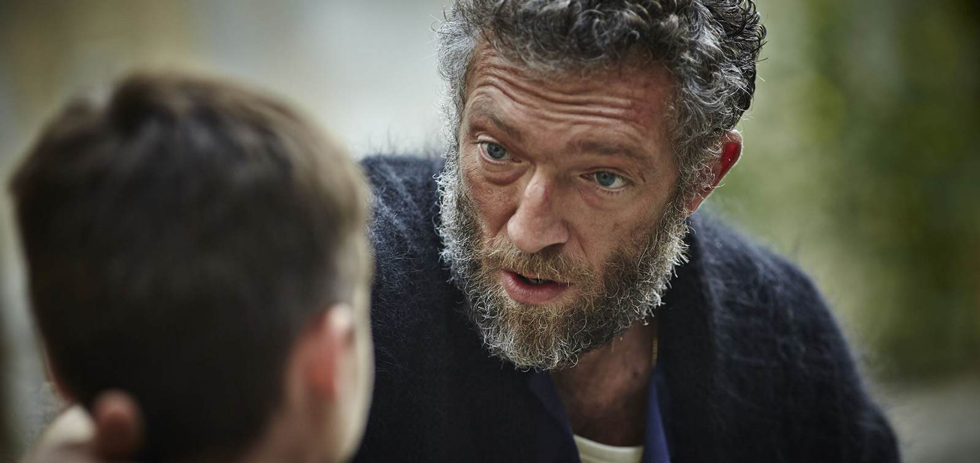
A little way into Ariel Kleiman’s Partisan, once a mood of lurking unease has settled in, a group of children, faces painted and dressed in their best clothes, cluster around an old television set for a Friday night ritual: popstar karaoke. This week, their father Grigori (Vincent Cassel) announces, two children will share the coveted honour of singing. Called onto the stage are Ariana (Anastasia Prystay), who has successfully completed two errands, and Alexander (Jeremy Chabriel), who, despite his “naughtiness” (the word, rich with the promise of mischief always forgiven, sticks in Cassel’s mouth) has this week amassed the most gold stars. “He’s a very hard working boy,” Grigori says, pulling Alexander toward him, “and reminds us every day that his is a heart that beats truly and powerfully.” The children hover, large, painted gold microphones in hand, as Grigori puts the DVD into the player. The song, a spangling synth-drenched duet written especially for the film by English electro group Metronomy, has vague, adult words that, in the children’s mouths, seem to well up from the unconscious.1 “Sometimes to tell the truth,” they sing, “is the hardest thing to do.”
Partisan is Melbourne director Kleiman’s first feature. Like his award-winning shorts, Young Love (2009) and Deeper Than Yesterday (2010), it is chiefly concerned with the affective possibilities of surface texture, colour, sound and movement. The story of a boy’s growing disillusionment with the world of his father, it is set in a place that is not quite anywhere and a time that could be any moment in the past thirty years. At the centre is the father, the Pied Piper-like Grigori, who has built a family of sorts from a collection of mothers and children. They live together in a self-contained warren of dark rooms set around a central courtyard, only accessible from the outside world through hidden doors. The compound’s aesthetic is a mix of chop shop, public primary school (a row of square blue backpacks hang on name-assigned hooks), European zoo enclosure and share house party, with long tables of home-cooked food, mismatched plates and lonely fairy lights. The mothers wear costume jewellery, sharp stilettos and bright dresses, the young boys wear suit jackets with wide shoulder pads. In contrast to the compound’s tarnished walls, their clothes always look just pressed. But, as in a fairytale, the seductively decorated surface is there to conceal a darkness. The women are all seeking refuge from abuse or mistreatment and Grigori is training the children to carry out the assassinations from which he makes his living.
The children adore Grigori and the world of playful training he has created and the film aligns itself with their innocent gaze. Surrounding Cassel with a cast of non-actors was a bold choice and one that heightens the sway his character holds over the others. He is frequently shot from a child’s eye height as he leads elaborate games that mimic (rather sadly) life in the outside world. In one scene, he sets up an indoor beach, with blow-up pools and palm trees and tumbles in the shallow water with the children, his smile dazzling. But as the oldest child, Alexander, begins to doubt Grigori’s authority, the tension ticking under Cassel’s skin seems to inch closer to the surface. His performance is one of minor gestural explosions and passive-aggressive announcements. His displeasure erupts with a twitch of the eye, a curl of the lip, a flared nostril. At the end of Alexander and Ariana’s karaoke, he silently mouths the last words along with them, tears pooling in his eyes. Through these tiny physical marks, Cassel plays Grigori as a fairytale father-villain, a man with an injured soul driven by a desperate desire to control his world and hold on to what he loves.2
In the end, the compound’s tense peace is disrupted, but what ultimately happens is left unanswered. The film’s final moments feel a little too unresolved to hold the film, but, like Brian De Palma and Abel Ferrara, Kleiman understands how the cinematic surface can transmit moments of intense, imaginative pleasure. In this regard, he does a superb job. The production, costume and sound design (by Sarah Cyngler, Maria Pattison and Robert Mackenzie, respectively) all work together to evoke a world of seductive, ungraspable danger that is as dark and wondrous as any bedtime fairytale.
